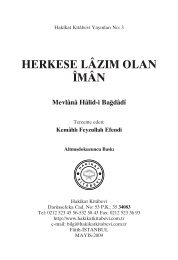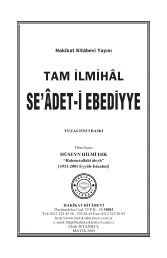5-Endless Bliss Fifth Fascicle - Hakikat Kitabevi
5-Endless Bliss Fifth Fascicle - Hakikat Kitabevi
5-Endless Bliss Fifth Fascicle - Hakikat Kitabevi
You also want an ePaper? Increase the reach of your titles
YUMPU automatically turns print PDFs into web optimized ePapers that Google loves.
Its doors were no more than hanging curtains. The rooms were on<br />
the south, east and north sides of Masjîd. Some of them were<br />
made of sun-dried bricks. The doors of most of them opened into<br />
Masjîd. Their ceilings were a span higher than a man of medium<br />
stature. There was a door between the rooms of Hadrat Fâtima and<br />
Hadrat Âisha. A few days before his passing away, he had the<br />
doors of the Sahâba’s rooms opening into Masjîd closed, with the<br />
exception of that of Abû Bakr.<br />
In the seventeenth year of the Hegira, Hadrat ’Umar ‘radiyallâhu<br />
anh’ had Masjîd enlarged on the north, west and south sides. With<br />
the rooms belonging to the Zawjât-i-tâhirât ‘radiy-Allâhu ta’âlâ<br />
anhunna’ being on the east side, he did not do any enlargement on<br />
the east side. Thus, its south-north wall became a hundred and<br />
forty dhrâ’ [seventy metres] and the east-west wall became a<br />
hundred and twenty dhrâ’. He said, “I would not enlarge Masjîd if I<br />
had not heard the Prophet’s command: ‘It is necessary to enlarge<br />
my Masjîd!’ ” He had the new walls made of sun-dried bricks and<br />
date branches like the old ones. Hadrat Abbâs donated his room,<br />
which was adjacent to the west wall. Half of Ja’fer Tayyâr’s house<br />
adjacent to it having been bought, the two were added to Masjîd-isherîf.<br />
In the meantime hadrat ’Umar had the Hujra-i-sa’âda<br />
restored with sun-dried bricks. In the thirtieth year of the Hegira<br />
hadrat ’Uthmân had these walls demolished again and the Masjîd<br />
enlarged. He had the new walls and the pillars made of stone and<br />
the ceiling of teak timber. A hadîth conveyed by Abû Hureira<br />
declares, “If they enlarged my Masjîd as far as San’â city in<br />
Yemen, all of it would be my Masjîd.”<br />
In the eighty-eighth year the Caliph Walid gave an order to the<br />
governor of Medina ’Umar bin Abdul’azîz, having all four walls<br />
demolished, whereby the rooms of the Zawjât-i-tâhirât, which were<br />
on the east side, were added to Masjîd. The four walls of the Hujrai-sa’âda<br />
were demolished and rebuilt with dressed stones from the<br />
base. As the base was being dug out Hadrat ’Umar’s one foot was<br />
seen. It had not rotted at all. A second wall was built around the<br />
Hujra. It had no doors. The ceiling of the Hujra became half a metre<br />
higher than Masjîd, and Masjîd became two hundred dhrâ’ long and<br />
a hundred and sixty-seven dhrâ’ wide. Forty craftsmen had been<br />
brought from the east Roman Empire, and the walls, the pillars, and<br />
the ceiling were ornamented with gold. For the first time, the mihrâb<br />
and four minarets were built. The work took three years. In the<br />
hundred and sixty-first year Mahdî, one of the Abbasid caliphs,<br />
- 127 -











